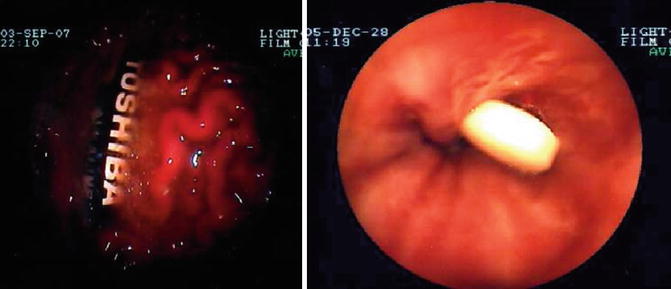Classification
Lesion
Rebleeding rate
Grade Ia
Arterial spurting hemorrhage
High
Grade Ib
Oozing hemorrhage
High
Grade IIa
Visible vessel
High
Grade IIb
Adherent clot
Medium
Grade IIc
Dark base (hematin covered lesion)
Low
Grade III
Lesion without active bleeding
Low
These scoring systems are valuable for predicting the risk of death, longer hospital stay, surgical intervention, and recurrent bleeding (Fig. 11.1).

Fig. 11.1
Endoscopic appearance of various lesions according to Forrest classification
11.2 Foreign Body Removal
Ingestion of foreign bodies may be accidental or intentional.
Patients are generally distressed and cannot swallow.
Endoscopy should be performed urgently under the following circumstances.
1.
Patients who cannot swallow saliva
2.
Impacted sharp objects
3.
Ingestion of button batteries (which can disintegrate and cause local damage)
Removal of other foreign bodies is less urgent.
Techniques:
At or above the cricopharyngeus, foreign objects can be removed with rigid instruments.
For small, slippery, pointed, or sharp objects (pins, razor, etc.), flexible gastroscopy is preferred: use of an overtube is recommended to avoid damage to the esophagus and pharynx (Fig. 11.2).

Fig. 11.2
Gastric (battery) and esophageal (pill) foreign bodies
Packets containing illicit drugs (plastic wrappings or tubes swallowed) can be removed with snare, care being taken to avoid damaging the covers.
For gastric bezoars, large polypectomy snares are used to fragment the bezoar into smaller pieces so that these can pass spontaneously.
Small batteries warrant immediate removal because of the high risk of local and systemic toxicity, and the smooth surface can be grasped with a basket.
11.3 Corrosive Injury of the Upper GI Tract: Esophageal Perforation and Stenting
Ingestion of corrosive agents initiates a progressive injury of the upper gastrointestinal tract, the extent of which depends on the agent, its concentration, quantity, and physical state, as well as the duration of exposure.
While plain films of the chest and the abdomen can reveal possible perforations of the upper gastrointestinal tract, early endoscopy remains the standard method of diagnosis and evaluation of the esophagus and the stomach.
Endoscopy is safe, but it must be performed by an experienced endoscopist and avoid unnecessary movements and too much insufflation of air.
Stay updated, free articles. Join our Telegram channel

Full access? Get Clinical Tree







